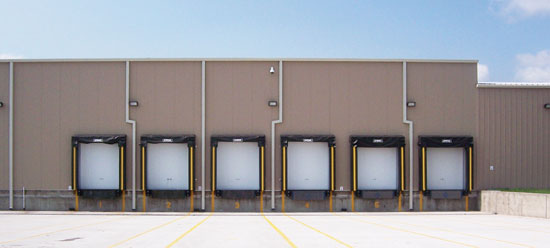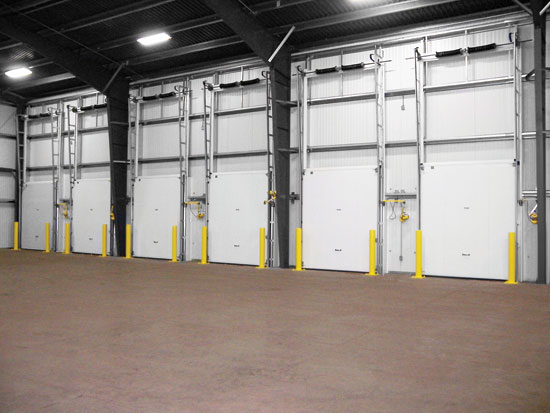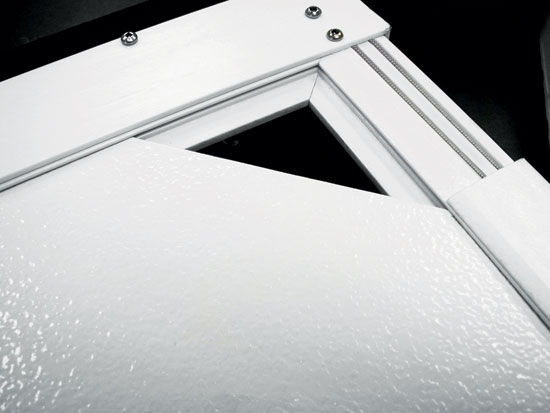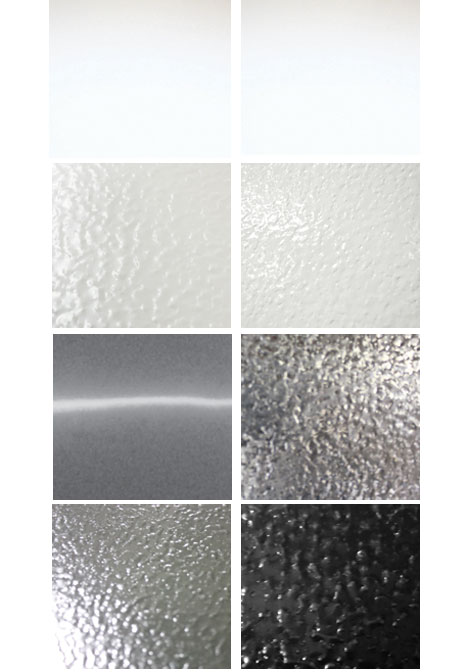Cold Storage Door Systems
Vertical Lift Doors
In locations where sidewalls are less available than overhead height and multiple doors are needed, vertical lift doors are a possibility. This type of door is common in general for warehouse loading dock applications and they can be manufactured to have all of the insulating and gasket sealing properties needed when the loading dock opens directly into a cold storage area. While they are appropriate for the potentially heavy-duty usage in these locations, they are considered best for locations that don't require a lot of opening and closing, say on the order of five times a day or less.


Photos courtesy of Chase Doors
Vertical track cold storage doors, shown here from the outside and inside of the building, are best suited for loading dock applications or where horizontal clearance is not otherwise available.
Vertical lift cooler doors and vertical lift freezer doors are both available with electric and manual operators just like horizontal sliding doors. They typically come with heavy-duty side tracks and hardware that can include a counterbalance weight system if desired. The gasket system covers the casing area that the vertical door closes down against and a continuous gasket along the door bottom seals that area. Freezer doors have perimeter heating and can also have heated pull cords in the freezer area to prevent them from freezing and binding up.
Code-Related Issues
Regardless of the door type selected, there are obviously code concerns anytime doors are used in buildings, particularly since these may be the only doors into or out of the enclosed cold storage areas. Hence, meeting code egress requirements is paramount so that there is no chance of anyone being stuck or stranded inside these spaces. The door size will need to be determined according to code just as with any other occupied space and the requisite egress hardware will need to be provided to allow proper and unfettered exiting. In the interest of avoiding “entrapment” door hardware that allows emergency escape or exiting, even if locked from the outside, can be critical and is commonly available.
If the door is part of a fire-rated enclosure, then obviously that door, frame, and related details need to be fire rated. This is not generally available for cold storage doors and may or may not be an issue. In cases where fire ratings are needed, it may be best addressed by constructing a conventional fire separation and door outside of the cold storage enclosure portion of the building with appropriate passage areas in between. Similarly, if the cold storage portion of the building needs to be handicapped accessible per building codes or the Americans with Disabilities Act (ADA), then all of the issues related to doors will apply. Size and operation are often not a problem given the range of choices and in some cases a sill or threshold can be avoided altogether depending on the door and frame construction type chosen. One solution that is not handicapped accessible however, is to add a personnel door within a larger sliding or vertical lift door. The bottom of the larger door will require a continuous member across the bottom that will be too high to meet handicapped accessibility requirements. If the entire door is automatically operated and can otherwise be accessible, then that limitation becomes unimportant.
Cold Storage Door and System Fabrication
The construction of door panels for cold storage doors has come a long way since the 1800s. Because of its low cost and availability, wood has been a traditional material of choice for cold storage door manufacturers. However, its tendency to warp, swell, and rot because of the high moisture environment it is subjected to created numerous problems for maintaining a good perimeter seal. Further these conditions encourage wood to harbor bacteria, mold, and fungus, meaning it is no longer acceptable to most health inspection agencies. Pressure treated wood solved the rotting problem for a while but unfortunately it warps even more than untreated wood.
As manufacturers began to look for a strong, non-wood door at a competitive price, they looked for a better material to make a better product. After considerable research and development, a popular and effective option emerged which replaced wood framing materials with fiberglass reinforced pultrusions (FRP). The well-known mechanical properties of fiberglass offer some tremendous advantages in cold storage applications not the least of which is its extremely low thermal conductivity. Compared to other structural materials, this meant that thermal performance of the door did not need to be unduly compromised by the presence of internal framing for the door panel. Fiberglass is also well known to be as strong as steel but 30 percent lighter in weight which helps in the operation of the door. It is impervious to water and moisture so it will never swell or rot and it is easy to clean. It also maintains its shape over a wide range of temperature differentials and will maintain all of its properties even in extremely cold conditions. Following all the way through on this approach, internal blocking for securely attaching hinges, handles, and other hardware reinforcements has also been replaced with an in-organic polymer material instead of the traditional wood.

Photo courtesy of Chase Doors
Fiberglass reinforced pultrusions with spray foam insulation has emerged as a superior means to construct a cold storage door panel.
The FRP framing is supplemented with spray foam insulation which provides the full thermal performance of the door. Some of the best designs use many ribbed cavities that capture and hold foamed-in-place polyurethane insulation. This produces an incredibly strong panel that has high impact resistance yet weighs notably less than traditional wood frame designs. And in the interest of maintaining an environmentally friendly product, the spray foam used is increasingly free of chlorofluorocarbons (CFCs).
As noted earlier, the inner and outer surfaces of the door panels are covered with a choice of metals including stainless steel, aluminum, or galvanized steel in smooth or textured finishes. It is also common to add a large kick plate to the lower portion of the door for added protection from day-to-day abuse. All fasteners used to create the frame, face sheets, and hinge or track hardware on the door are commonly stainless steel for the best long-term durability and rust resistance. By contrast, on swinging doors, heavy-duty chrome plated hinges and latches are common with nickel plated strap hinges fairly standard on larger doors.

Photos courtesy of Chase Doors
Some common metal finishes for cold storage doors









